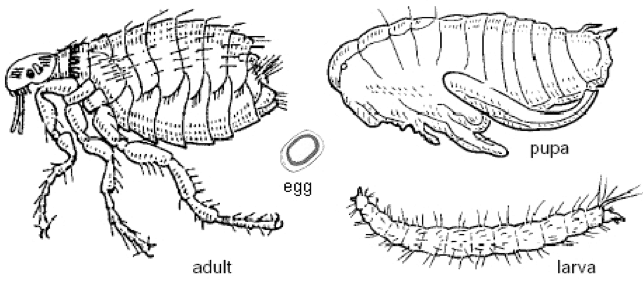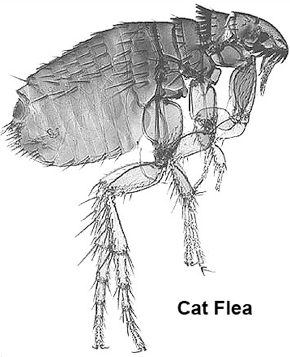Need flea control help on your property?
Training Guide for Fleas in Homes and Appartments
 We are most familiar with adult fleas, those specks that jump and occasionally bite, but spend most of their lives on cats and dogs. Fleas reproduce rapidly. Eggs are laid on the animal while it sleeps or rests. They are not sticky and fall down into the pet’s bed – where the offspring are most likely to find food.
We are most familiar with adult fleas, those specks that jump and occasionally bite, but spend most of their lives on cats and dogs. Fleas reproduce rapidly. Eggs are laid on the animal while it sleeps or rests. They are not sticky and fall down into the pet’s bed – where the offspring are most likely to find food.
The eggs hatch into tiny (1/8-inch) larvae; white, worm-like, legless and blind. They shy away from light and wiggle their way down into the animal’s bedding, carpet, grass, etc. This stage has chewing mouthparts and does not suck blood. They do, however, feed on digested blood in the form of feces from the adult fleas, as well as bits of dead skin, feathers and other organic debris. After growing through three molts (shedding of the exoskeleton) the larvae become pupae, spinning silken cocoons, which they camouflage by attaching bits of debris.
Perhaps a month after the eggs are laid, adult fleas emerge from their pupal cocoons. Emergence of adults is triggered by heat (of people and pets), carbon dioxide (breath) and by physical pressure (e.g., from people and pets walking or lying on them). Thus the movements of unsuspecting humans can attract newly-emerged cat fleas that would otherwise prefer cats and dogs. To improve chances of contacting a passing host, newly-emerged fleas tend to move upward on vegetation, carpet, drapes and furniture. Their eyes are most sensitive to yellow-green light – the color of vegetation – and they are attracted to dark moving objects against a light background, such as a dog against foliage, or a person against a wall. To contact a host, they jump a distance of up to one foot after detecting the presence of warmth and carbon dioxide. Once it makes contact, the cat flea begins feeding on the host’s blood. If dislodged, it usually dies within two days.
 Knowing the cat flea’s life cycle is critical to successful management of flea infestations. Control measures should focus on where the fleas are found and where they are suspected to be. Adult fleas are found on their hosts, so, pets should be treated with prescription or over-the-counter treatments. These include products containing fipronil or imidacloprid, active ingredients that kill fleas but have relatively low toxicity. This allows them to be applied as spot treatments directly onto pets. Another, containing lufenuron, is a systemic product taken internally. It kills fleas when they feed on the pet. As with other pesticides, misapplications may unnecessarily expose people and pets, and may not provide adequate control. To get your pet treated, you may want to visit a veterinarian. Or, if you choose to treat the pet yourself, be sure to select the correct product and follow the label’s directions.
Knowing the cat flea’s life cycle is critical to successful management of flea infestations. Control measures should focus on where the fleas are found and where they are suspected to be. Adult fleas are found on their hosts, so, pets should be treated with prescription or over-the-counter treatments. These include products containing fipronil or imidacloprid, active ingredients that kill fleas but have relatively low toxicity. This allows them to be applied as spot treatments directly onto pets. Another, containing lufenuron, is a systemic product taken internally. It kills fleas when they feed on the pet. As with other pesticides, misapplications may unnecessarily expose people and pets, and may not provide adequate control. To get your pet treated, you may want to visit a veterinarian. Or, if you choose to treat the pet yourself, be sure to select the correct product and follow the label’s directions.
Newly emerged adult fleas, flea pupae and larvae, are found where infested animals rest and sleep. Typical flea “hot spots” include pet beds and bedding.
These should be washed regularly. Other hot spots are rugs, furniture (including spots under the furniture) and outdoors in and around dog houses, under porches and bushes. Carpeting, rugs and furniture should be vacuumed thoroughly and frequently. Promptly dispose of vacuum contents in sealed containers, such as plastic bags. After vacuuming, steam cleaning of furniture and floor coverings will help eliminate remaining fleas.
Flea traps also can be useful, placed wherever adult fleas are found or suspected. These devices are electric light traps. They emit light and warmth, attracting adult fleas, then capturing them on sticky inserts that are easily removed and replaced. Flea traps are a non-toxic supplement to other control methods, and valuable as monitors to discover and pinpoint flea activity. Flea traps alone, however, should not be expected to eliminate flea infestations.
The benefits of vacuuming cannot be overemphasized as a means of flea control. Vacuuming picks up all stages of fleas, directly reducing the population. It also removes dirt and spreads carpet fibers that can interfere with the penetration of pesticide applications (one reason why total release aerosol “bombs” are not very effective against fleas). In addition, physical pressure on the carpet from vacuuming can trigger the emergence of fleas from their pupal cocoons, exposing them to pesticide applications.
After vacuuming and cleaning, pesticides labeled for flea control can be applied as spot treatments. Products containing permethrin or pyrethrins may kill adult fleas, but not flea eggs and pupae. Dust formulations, such as those containing boric acid, silica or diatomaceous earth, will kill flea adults and larvae. These materials can be applied as a very fine layer of dust to areas likely to harbor fleas, such as rugs, carpeting, cracks in flooring, beneath furniture cushions, in crawl spaces and under porches.
“Broadcast” applications of pesticides to the entire carpeted area of a residence were once common practice for flea control. Today, few, if any, products are registered for this type of application because of concerns about pesticide use, and because fleas typically occupy certain spots within a structure. Fleas are unlikely to be in the center of a spacious room or sunny yard. This is because pets typically do not rest in these spots and they lack enough organic and fecal debris (from the feeding of adult fleas) to feed developing larvae. Also, fleas require relatively high humidity for development. A sunny spot in the middle of a lawn would usually be too hot in summer and have insufficient moisture and humidity to support fleas. Thus spot applications of pesticides are most effective.
Growth regulators such as methoprene or pyriproxyfen are another effective and less toxic alternative. Active for several months, growth regulators provide no “knock down” of adult fleas, but effectively disrupt the flea life cycle by preventing larvae from maturing into adults.
Note that where liquid pesticides are applied, all pets should be removed from the premises. Birds, reptiles, amphibians and fish are extremely sensitive to many pesticides. Before applications are made, pets should be removed or their containers tightly sealed. Aquarium filters and air pumps should be unplugged. Always read the product label for directions. After application, pets and people should be kept off treated surfaces until the surfaces are completely dry. Treated areas can then be vacuumed again to trigger the emergence and movement of fleas, increasing their exposure to the pesticide.
If you employ the various methods listed above, you should see a significant reduction in your flea population. You should not, however, expect to immediately eliminate all of the fleas. In the pupal stage, fleas are resistant to pesticides and may remain hidden in their cocoons to emerge weeks or even months later. Also, pesticides such as dusts and growth regulators, work slowly. In addition, you may have overlooked some flea hot spots.
Infested items, such as furniture, may have been brought in, adding to the flea problem. For complete flea elimination, call Eagle Pest Eliminators Inc. to schedule your safe flea elimination treatment!
130+ Reviews, avg 4.7 stars
Get A Quote Today
When you contact us for an estimate, our certified technicians will inspect your home and provide you with a detailed plan to eliminate those unwanted invaders. They will also discuss treatment options to ensure you are informed before they take any action.
Call our staff today at 425-398-7365. We will provide you with peace of mind, valuable information, and affordable service. We’ll get back to you within 1 business day.




